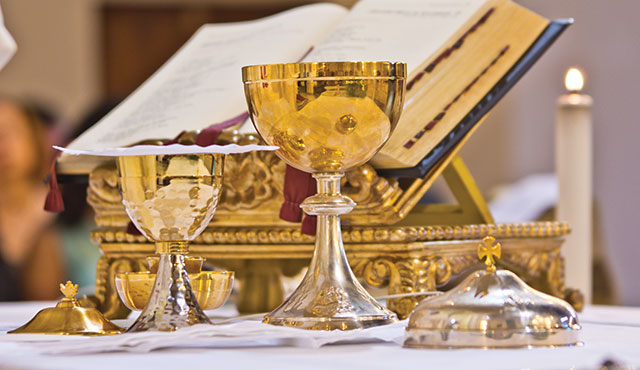Every family has a story. It begins long before we were born and continues with each generation through good times and bad; heroes and scalawags. Depending on who tells the story, the patterns and variations may be nuanced, but together we learn where we came from and where we might go.
The family of Christ, the Church, is no different. Our family story is retold over the course of three years, in the Liturgical Calendar of the Church which is the collection of solemnities, feast days and memorials that cycle through the celebration of Mass.
According to The Catechism of the Catholic Church, “Liturgy” originally meant public work, but in Catholic tradition it means the participation of the people of God in the work of God. Through the Liturgy, Christ our redeemer and high priest continues the work of redemption in, with and through his Church.
The Liturgical Calendar has evolved in many ways since the first apostles gathered to celebrate the Eucharist. Anyone who has attended a Jewish Sabbat, which is also a liturgical worship service, will notice similarities in structure because Christianity grew out of Judaism.
In the early centuries, there were separate texts and letters of varying authenticity and value, but the Bible as we know it wasn’t set as canon until 382 AD. Over the centuries our liturgy evolved separately in the various churches and there are still some optional memorials, depending on the diocese or country.
However, one of the many fruits of Vatican II was the creation of a common lectionary – the book that organizes the readings for Sunday Mass. Prior to Vatican II there was no three-year cycle as today. The post-Vatican II Mass is called the Novus Ordo, or new order. Since 1969, depending on the year, the gospel readings are predominantly from one of the synoptic gospels – Matthew, Mark and Luke, with the gospel of John appearing throughout each year, particularly at Easter. This, along with the first and second readings, means that over a three-year cycle, we have heard all of the New Testament and a good part of the Old Testament.
In the dialogue with the Lutheran, Episcopal and Methodist churches, the “ritual” churches have all adapted the same lectionary, which is why, if you go to an Episcopalian service, you will likely hear the same readings as given at a Catholic Mass.
Lesa Truxaw, director of the Office for Worship for the Diocese of Orange said, “The liturgical year is a pattern or cycle of celebrations that help us look at the salvific actions of Christ in a cyclical pattern of days. It is not so much a repetition, but more of a spiral, because what Christmas, for example, means to us in one year, may mean something quite different in another.”
Our Mass, which is profoundly biblical, has a framework, or “order,” which gives structure and continuity to the celebration of the Eucharist. The readings of the Liturgical Calendar move us through the Old Testament in Advent to the birth and life of Christ, culminating in the Resurrection at Easter. In 2020, we were in the Liturgical Year A – highlighting Matthew’s gospel. This year B, 2021, we will be reading the gospel of Mark. And next year, 2022, we will read Luke’s gospel. All three synoptic gospels tell similar stories, but with slight variations based on the writer and the audience for whom each wrote.
Repeating this cycle doesn’t mean we are repeating ourselves. Like great art, a great performance, or a great book, every time we see or read it, we get something new and fresh. According to Katie Dawson, director of Parish Faith Formation, “The beauty of the liturgical year, the Church year, is that we travel the same road over and over again and we are invited into God’s story each time. The story has endless depth – and we are asked to go deeper and deeper with each cycle, drilling down and opening up. As we complete one season of anticipation and preparation and celebrate a great feast, we are not finished!”
Through the Liturgical Calendar and the celebration of the Eucharist, the Church instructs and heartens the faithful to go forward as Jesus commanded to spread the good news to all people.

